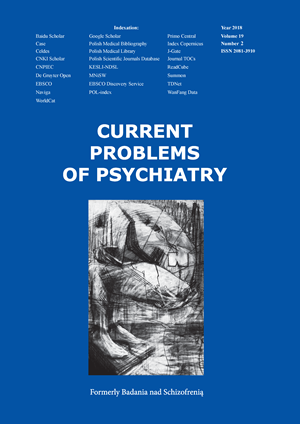The society’s perception of suicide
DOI:
https://doi.org/10.1515/cpp-2017-0008Słowa kluczowe:
samobójstwo, próba samobójcza, ocena społeczna, badanie ankietoweAbstrakt
Wstęp: Ze względu na swój radykalny i ostateczny charakter, samobójstwa wzbudzają w społeczeństwie wiele emocji. Konsekwencje samobójstw podlegają moralnej ocenie w trzech głównych kontekstach: religijnym, psychologicznym i społecznym. Ze względu na złożoność społeczeństw, zrozumiałym jest, że poziom wiedzy oraz ocena moralna aktu samobójczego są bardzo zróżnicowane.
Materiały i metody: Badanie ankietowe przeprowadzono wśród 168 respondentów w wieku 18-49 lat. W badanej populacji znajdowało się 69 kobiet i 99 mężczyzn.
Wyniki: Ankietowani wskazywali, że najczęściej samobójstwa popełniają ludzie młodzi (72,5%) oraz mężczyźni (22,7%). Znaczna część badanej populacji miała osobiste doświadczenia z osobami po próbach samobójczych (41,9%). Spośród ankietowanych, większość (49,7%) jest zdecydowanie przeciwna samobójstwom, natomiast 46,1% uważa, że nie można osądzać ani potępiać takich osób.
Wnioski: Respondenci dysponowali szeroką wiedzą na temat samobójstw i ich najczęstszych przyczyn. Choć sami nie popierają tego zachowania, nie potępiają go i znają sposoby zapobiegania aktom samobójczym
Bibliografia
1. Durkheim E.: Samobójstwo: studium z socjologii. Oficyna Naukowa, Warszawa 2006.
2. Borys B.: Sytuacje ekstremalne i ich wpływ na stan psychiczny człowieka. Psychiatria, tom I, nr 2., 2004.
3. Komenda Główna Policji, http://statystyka.policja.pl/st/wybrane-statystyki/samobojstwa access 20.05.2017
4. Dąbrowski S., Jaroszyński J., Pużyński S. (red.): Psychiatria. Państwowy Zakład Wydawnictw Lekarskich, Warszawa 1989.
5. Carson R., Butcher J., Mineka S.: Psychologia zaburzeń, tom I. Gdańskie Wydawnictwo Psychologiczne, Gdańsk 2003.
6. Strelau J. (red.).: Psychologia. Podręcznik akademicki. Tom III. Gdańskie Wydawnictwo Psychologiczne, Gdańsk 2005.
7. Anholcer-Binczycka M. (red.): Agresja i przemoc a zdrowie psychiczne. Wydawnictwo PTHP, Warszawa 2001.
8. Anthony M.T.: Dlaczego? Samobójstwo i inne zagrożenia wieku dorastania. Oficyna wydawnicza Vacatio, Warszawa 1994.
9. Pilecka B.: Wybrane zagadnienia samobójstw młodzieży. Wydawnictwo Fundacji „Masz szansę”, Lublin 1995.
10. Nowak A (red).: Wybrane zjawiska powodujące zagrożenia społeczne (rozpoznawanie i przeciwdziałanie). Oficyna wydawnicza Impuls, Kraków 2000.
11. Gelaye B., Addae G.: Poor sleep quality, antepartum depression and suicidal ideation among pregnant women. J Affect Disord. 2016 Nov 18;209:195-200.
12. Oexle N.,Waldman T.: Mental illness stigma and suicidality: the role of public and individual stigma. Epidemiol Psychiatr Sci. 2016 Dec 6:1-7.
Pobrania
Opublikowane
Numer
Dział
Licencja
Prawa autorskie (c) 2017 Autorzy

Praca jest udostępniana na licencji Creative Commons Attribution-NonCommercial-NoDerivatives 3.0 Unported License.


